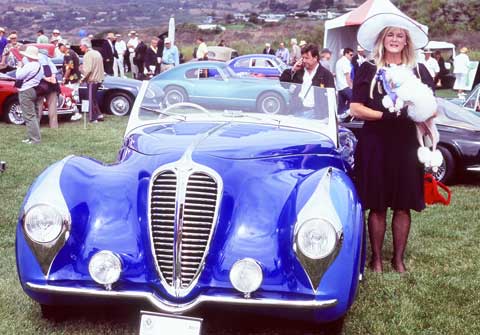
1947 Delahaye 175S cabriolet in good company. Photo by Wallace Wyss.
By Wallace Wyss
September 19-21 2008
Palos Verdes Concours d’Elegance, now in its 16th year, has moved up a notch to become the premier concours event in the Southern California community. As far as best show overall in the U.S., if not the world, the honor still goes to Pebble Beach, which has been going on now for over 50 years.
Newport Beach Concours, held this year at a luxury hotel in Dana Point, has promise but the Palos Verdes Concours d’Elegance showed that by reaching out to fans of the Sixties, they are “moving with the timesâ€, having cars that appeal to those who grew up in the fifties and sixties. Sometimes it is jarring to see a car that you remember from high school in a concours, but, hey, maybe it’s been 40 years since you graduated!
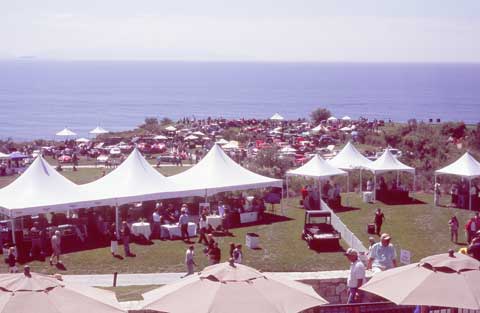
Competition for Pebble Beach? Looks good from here. Photo by Wallace Wyss.
The Palos Verdes Concours d’Elegance should be one of the best because it’s situated in an ideal place—the Trump National Golf Course projecting out into the blue Pacific. The Palos Verdes Peninsula in many ways mirrors the Monterey Peninsula of Northern California with its many Eucalyptus, Cypress and elegant homes. The event has a very supportive audience of auto industry-connected collectors, and the South Bay is an area known for its good taste in antiques and art.
Bring all this together with some world class judges and you have a great concours. The weekend also features a drive of vintage cars the day prior to the concours event and a posh Grand Marshal’s Charity Dinner Gala offering silent and live auction items kicks off the weekend, proceeds going to charity. They even invited reporters to lunch the day of the concours, and I have to say, “The treatment far exceeded my journalistic experience at any other concours press luncheon. I’d learn to play golf if their fare is always that good”.
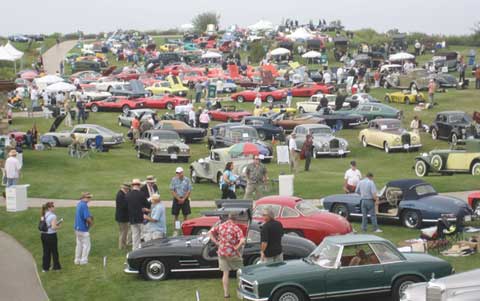
Grazing in the lush fields of Palos Verdes.
The Tour d’Epicure Road Rallye was an extra special attraction. This year it featured a murder mystery theme where a body has been found and rushed to the morgue in a classic hearse, with all the classics entered in the event giving chase. They “return to the scene of the crime†after collecting clues, arriving at a very fancy shopping center called the Promenade. This gives entrants a chance to see the incredible view of the ocean that one sees when driving around Palos Verdes and allowed for local shoppers on the Peninsula to see some outstanding cars. Â
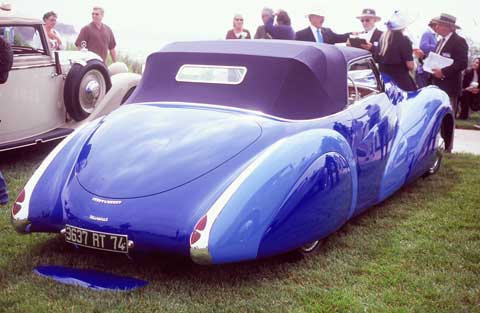
Rear view of the fantastic 1947 Delahaye 175S. Photo by Wallace Wyss.
Similar to prior concours at Palos Verdes, they have a theme and this year the honored marque was Cadillac. The Palos Verdes Concours d’Elegance strives to have significant cars in each category. Among the 2008 winners was a 1927 Cadillac Dual Cowl Phaeton which won Antique Cars-First Place. Several of the Cadillac cars had V-16s, almost unknown by most people who were raised in the post war period and quite a few had V-12s.
At this year’s show, there was surprising strength in the fifties American car class.  The Cadillac Eldorado Biarritz models were popular; these being hand-built looking cars (though they were built on an assembly line) with four doors, the rearward doors being rear hinged like today’s Rolls Royce Phantom. They had brushed metal roofs as well. In fifties American cars a 1953 Buick Skylark was showing off its wire wheels, but a Pontiac station wagon took first in class.
The entering of a station wagon marks a new turn in the road for concours—because a wagon is not just the ultimate luxury model of each marque but a “utilitarian†family vehicle. Yet they are coming up strongly as “forgotten†cars that deserve honoring if they are done correctly. A 1953 Olds Fiesta was of interest to any car lover from the fifties who remembered that Olds Fiesta hubcaps with their “spinners†were a popular target of thieves.
Another surprising model this writer didn’t expect to see at concours was a 1965 Impala Super Sport convertible—just another sign of how old we’re getting and just how much spectators like to see cars they remember from their youth. There were two Buick Riveras on display. In car collector circles, Riviera cars of the Sixties are finally being acknowledged as special cars, the result of GM VP Bill Mitchell wanting to have a “personal luxury car†with the sharp edged roofline of a Rolls Royce.
Two Corvair Monza convertibles were on display. “It’s about time that the Corvair is recognized as a collectible car by concours organizers,†according to this author. Sent into ignominy by Ralph Nader, they were unique cars but had to be abandoned when Nader wrote a book impugning their handling. There were also two other Corvair including a Monza Spyder coupe which won first in class.
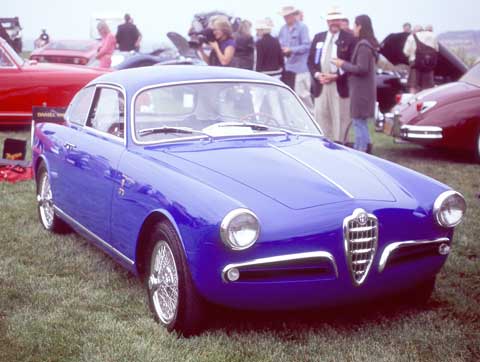
1st place in Sports Cars went to a beautiful Alfa Veloce Sprint. Photo by Wallace Wyss.
In Sports Cars, we liked the lines of the 1951 Jowett Jupiter which won 3rd in class. A Triumph TR3A was 2nd in class and 1st place went to a beautiful Alfa Veloce Sprint. A Gullwing coupe was matched by a 1961 300SL roadster and in the Morgan section there was an aerodynamic example from a time when Morgan thought they needed an updated body. There were three additional Morgans gracing the turf as well.
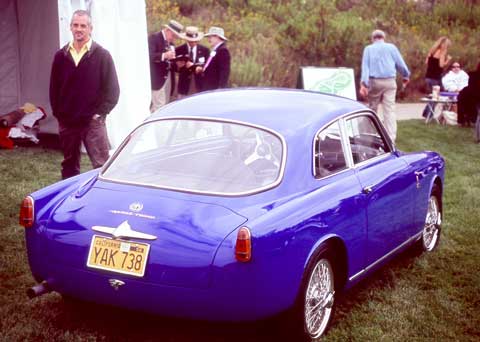
Rear view of heavily accessorized Sprint. Note the plexiglass windows, standard issue for a very early Veloce. Photo by Wallace Wyss.
There were three 356 Porsches, generally considered “old enough†to be classics, but the surprise was a 1965 912 coupe, a model almost forgotten—the  one year that a Porsche 911 body style had a VW engine.
The most impressive Porsche of all was one not even built by Porsche, if you can accept that description. It was a 1952 Porsche Glockler racing car, which was Porsche built by a man named Glockler. When a private entrant beat the Porsche factory cars and this car began to win races in the fifties, Porsche bought the Glockler design and made sure that its ideas were incorporated into the cars they were building at the time. This example had a beautiful eggshell-thin aluminum roof. It is owned by Her and Rose Wysard of Fullerton, CA who are to be congratulated for picking such a rare model to restore.
Among the other prewar cars was a 1939 Lincoln Zephyr V12, a rarely shown car, perhaps because the engine is a rare bird. The cars design was taken from a rear engine vehicle designed by a man named John Tjaarda (Tom’s father) before the war. First place in the same prewar class went to a 1941 Packard 1905 Rollson Convertible Limo which was a treat to see because Rollson was a custom coachbuilder, doing limos. This one had a convertible top in back and a hardtop fixed roof center in the middle.
Â
Postwar Italian cars were not neglected. Among the outstanding Italian cars was a 1971 Lamborghini Miura SV/J Jota, pronounced “Yawtaâ€. The original Jota was built as a super Miura by Bob Wallace and was sold to a rich industrialist in Brescia, who, according to Wallace, destroyed the one and only Jota in an accident. We did not find out if this was a regular SC made into a Jota, or this may have been one of the specials built for the Shah of Iran who had enough clout to get one offs built to his taste.
Â
 In Ferraris, the 250GTL “Lusso†was represented with two fine examples, both good arguments that the Lusso is the most beautiful road Ferrari. Much more rare and elegant was a 400SA Superamerica.
Â
Baroque and elegant was the 1948 Delahaye Faget-Varnet brought up from Escondido, but the Most Elegant award went to an American car, a 1934 Cadillac convertible coupe. Â Best paint went to a 1947 Delahaye 175S cabriolet from Escondido and Best Design to the 1963 Ferrari Lusso of Shawn Williams.
In sum, the Palos Verdes Concours d’Elegance in some ways was superior to the Pebble Beach Concours d’Elegance; its location for instance is high above the sea, so it’s less prone to cold ground hugging fog than Pebble. But it will remain slightly controversial how “new†a car can be eligible and the staff is careful to consider this each year. For instance we saw a 1984 Boxer Berlinetta entered, which fit perfectly into the broad display of Porsche cars. While it’s a rare and fast purebred car, you just know the Old Guard at Pebble is not willing to go past the sixties, let alone embrace anything from the Eighties.
But time and the audience moves on, and we hope the Palos Verdes Concours d’Elegance becomes as much of a September concours staple in Southern California and across the United States for that matter as Pebble is in the North each August. This event is definitely a concours must-do on the annual calendar and we expect to see more and more serious collectors getting involved.
Dear Wallace,
May I just note that the blue Alfa which won the concours at Palos Verdes would never have won in Europe? The spoke wheels are awful and have originally never been attached to any Giulietta. Looking through the perspex of the rear window I can also see an steering wheel which is not an Alfa Romeo-item, maybe it is a much later Nardi wheel. Let us please pledge for historic cars to remain just what they are: historic cars, like the once have left the factory. So please stop over-restoring cars, putting chrome on parts which were originally painted and putting wheels on which have never been used when the car was new, or in its first years.
By the way: the Porsche 912 had a 356 4-cilinder engine, not a VW one.
Kind Regards,
Bart van den Acker
(Alfa Sprint owner, as you might have guessed)
author’s response to letter:
Having once owned a car with Borrani wire wheels and having left them at a restoration shop for restoring, I discovered there some Borranis made for Alfas. So in the owner’s defense, I say if the item was available as an option at the time the car was in production and some owners had them installed, I would consider it an interesting plus if I was a concours judge. What’s really fun, for instance, is a VW 21-window microbus with every conceivable camper option. What I liked about this car with the metal Conrero badge. I had no idea that merely having your car tuned by the maestro of speed could earn you a metal badge of such high quality. So that’s my opinion–I don’t mind aftermarket options as long as they were available at the time the car was in production and sometimes installed by owners.
Wallace,
Sprint Veloce were racing cars, especially when factory bumpers were taken off. There has never been a Veloce light weight with heavy wire wheels. No picture shown up from the sixties.
regards Martin
Wally, Thanks for the nice article. A point of order: the Cadillac sedan you saw was an Eldorado Brougham, available in 4 years, from 1957-1960. Total production of all sedans was 904. These cars are in every sense truly modern classic cars (and I am not even a Cadillac guy!). The individual years are quite different, and the final version was built by Pinninfarina. The Seville was a coupe, first made in 1956, and the Biarritz was the convertible version, quite different from the Eldorado Brougham and really just tarted-up production cars, unlike the Eldorado Brougham, which was hand-built regardless of cost to be the finest car in the world.
The Eldorado Brougham has only just recently begun to get the credit it deserves, both by the automotive press and the collector car market. The original series (1957 & ’58 models) share virtually nothing with the rest of the Cadillac line. The Brougham engine for those years is different from the standard Cadillac engine and not just in horsepower rating. Note the location of the oil filter. Beyond the obvious styling advances (quad headlamps, suicide doors, brushed stainless steel roof), the mechanical firsts are myriad. Automatic starter, automatic locking doors, memory seat, polarized sun visors, vanity items, trunk release AND pull down, air suspension, rear seat heaters, on and on. Of the two first series examples shown, only one of them was still on air suspension.
The sighting of a 1959 Eldorado Brougham is a rare spectacle. Only 99 were built and approximately 20 exist. This example, too, was still on air suspension. Every body panel and piece of glass is unique to that car. Only the front bumper is stock Cadillac. They were built by Pinin Farina in Turin but designed in Detroit by Cadillac. Magnificent cars, truly the Duesenberg of its day.